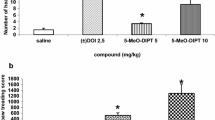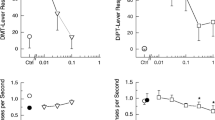Summary
The potential 5-HT1A antagonist properties of the ß-antagonist tertatolol were assessed using biochemical and electrophysiological assays in the rat. (±) Tertatolol bound with high affinity (Ki = 38 nM) to 5-HT1A sites labelled by [3H]8-OH-DPAT in hippocampal membranes. The (−)stereoisomer (Ki = 18 nM) was about 50-fold more potent than the (+)stereoisomer (Ki = 864 nM) to inhibit the specific binding of [3H]-8-OHDPAT. As expected of a 5-HT1A antagonist, (−)tertatolol prevented in a concentration-dependent manner (Ki = 24 nM) the inhibitory effect of 8-OH-DPAT on forskolin-stimulated adenylate cyclase activity in rat hippocampal homogenates. Furthermore in vivo pretreatment with (−)tertatolol (5 mg/kg s.c.) significantly reduced the inhibitory influence of 8-OH-DPAT (0.3 mg/ kg s.c.) on the accumulation of 5-hydroxytryptophan in various brain areas after the blockade of aromatic L-amino acid decarboxylase by NSD-1015 (100 mg/kg i.p.). In vitro (in brainstem slices; Ki ∼ 50 nM) and in vivo (in chloral hydrate anaesthetized rats; ID50 ∼ 0.40 mg/kg i.v.), (−)tertatolol prevented the inhibitory effects of the 5-HT1A receptor agonists 8-OH-DPAT, ipsapirone and lesopitron on the firing rate of serotoninergic neurones within the dorsal raphe nucleus. In about 25% of these neurones, the basal firing rate was significantly increased by (−)tertatolol (up to +47% in vitro, and +30% in vivo). These data indicate that (-)tertatolol is a potent competitive antagonist at both pre (in the dorsal raphe nucleus) - and post (in the hippocampus) - synaptic 5-HT1A receptors in the rat brain.
Similar content being viewed by others
Abbreviations
- ACSF:
-
artificial cerebrospinal fluid
- BMY-7378:
-
8-[2-[4(2-methoxy-phenyl)-1-piperazinyl]ethyl]-8-azaspiro-[4,5]-decane-7,9dione
- DRN:
-
dorsal raphe nucleus
- 5-HIAA:
-
5-hydroxyindole acetic acid
- 5-HT:
-
5-hydroxytryptamine (serotonin)
- 5-HTP:
-
5-hydroxytryptophan
- MDL 73005 EF:
-
8-[2-[(2,3-dihydro-1,4-benzodioxin-2-yl)-methylamino]ethyl]-8-azaspiro-[4,5]-decane-7,9-dione, methyl sulfonate
- NAN-190:
-
1-(2-methoxyphenyl)-4-[4-(2-phthalimido)butyl]piperazine
- 8-OH-DPAT:
-
8-hydroxy-2-(di-n-propylamino) tetralin
- (S)-UH-301:
-
(S)-5-fluoro-8-hydroxy-2-(dipropylamino) tetralin
- WAY-100,135:
-
N-tert-butyl-3,4-(2-methoxyphenyl)-piperazin-1-yl-2-phenylpropanamide
References
Adrien J, Lanfumey L, Gozlan H, Fattaccini CM, Hamon M (1989) Biochemical and electrophysiological evidence for an agonist action of CM 57493 at pre- and postsynaptic 5-hydroxytryptamine1A receptors in brain. J Pharmacol Exp Ther 248:1222–1230
Aghajanian GK (1982) Regulation of serotonergic neuronal activity: autoreceptors and pacemaker potentials. Adv Biochem Psychopharmacol 34:173–181
Amsterdam JD (1992) Gepirone, a selective serotonin (5-HT1A) partial agonist in the treatment of major depression. Prog Neuro-Psychopharmacol & Biol Psychiat 16:271–280
Arborelius L, Svensson TH (1992) Effects of a novel 5-HT1A receptor antagonist, UH-301, and (R)-8-OH-DPAT on the activity of dorsal raphe (DRN) 5-HT neurons and DA neurons in the ventral tegmental area (VTA). In: Serotonin: Animal models and clinical targets. 3rd ITEM-Labo Symp, Paris, Feb 1992, Abstr 3, p 12
Barbaran JM, Aghajanian GK (1980) Suppression of serotonergic neuronal firing by α-adrenoceptor antagonists: Evidence against GABA mediation. Eur J Pharmacol 66:287–294
Björk L, Cornfield LJ, Nelson DL, Hillver SE, Anden NE, Lewander T, Hacksell U (1991) Pharmacology of the novel 5-hydroxytryptamine1A receptor antagonist (S)-5-fluoro-8-hydroxy-2-(dipropylamino) tetralin: inhibition of (R)-8-hydroxy-2-(dipropylamino) tetralin-induced effects. J Pharmacol Exp Ther 258:58–65
Blier P, Steinberg S, Chaput Y, De Montigny C (1989) Electrophysiological assessment of putative antagonists of 5-hydroxytryptamine receptors: a single-cell study in the rat dorsal raphe nucleus. Can J Physiol Pharmacol 67:98–105
Boddeke HWGM, Fargin A, Raymond JR, Schoeffter P, Hoyer D (1992) Agonist/antagonist interactions with cloned human 5-HT1A receptors: variations in intrinsic activity studied in transfected HeLa cells. Naunyn-Schmiedeberg's Arch Pharmacol 345:257–263
Borison RL, Albrecht JW, Diamond BI (1990) Efficacy and safety of a putative anxiolytic agent: ipsapirone. Psychopharmacol Bull 26:207–209
Cheng YC, Prusoff WH (1973) Relationship between the inhibition constant (K1) and the concentration of inhibitor which causes 50 percent inhibition (IC50) of an enzymatic reaction. Biochem Pharmacol 22:3099–3108
Costall B, Domeney AM, Farre AJ, Kelly E, Martinez L, Naylor RJ (1992) Profile of action of a novel 5-hydroxytryptamine1A receptor ligand E4424 to inhibit aversive behavior in the mouse, rat and marmoset. J Pharmacol Exp Ther 262:90–98
de Blasi A, Lipartiti M, Pirone F, Rochat C, Prost JF, Garattini S (1986) Reduction of beta-adrenergic receptors by tertatolol: an additional mechanism for beta-adrenergic blockade. Clin Pharmacol Ther 39:245–254
de Lean A, Stadel JM, Lefkowitz RJ (1980) A ternary complex model explains the agonist-specific binding properties of the adenylate cyclase-coupled ß-adrenergic receptor. J Biol Chem 255:7108–7117
de Vivo M, Maayani S (1986) Characterization of the 5-hydroxytryptamine1A receptor-mediated inhibition of forskolin-stimulated adenylate cyclase activity in guinea pig and rat hippocampal membranes. J Pharmacol Exp Ther 238:248–253
di Scenna P (1987) Method and myth in maintaining brain slices. In: Schurr A, Teyler TJ, Tseng MT (eds) Brain slices: Fundamentals, applications and implications. (Conference, Louisville, KY, 1986), Karger, Basel, pp 10–21
Fargin A, Yamamoto K, Cotecchia S, Goldsmith PK, Spiegel AM, Lapetina EG, Caron MG, Lefkowitz RJ (1991) Dual coupling of the cloned 5-HT1A receptor to both adenylyl cyclase and phospholipase C is mediated via the same Gi protein. Cellular Signalling 3:547–557
Fletcher A, Bill DJ, Brammer NT, Cliffe IA, Forster EA, Reilly Y, Lloyd GK (1991) WAY 100135: a novel and highly selective 5-HT1A receptor antagonist. Soc Neurosci Abstr 17:39.3
Fornal CA, Litto WJ, Ribeiro-do Valle LE, Jacobs BL (1989) Role of somatodendritic autoreceptors in the regulation of serotonergic neuronal activity in behaving cats. Soc Neurosci Abstr 15:225.4
Gartside SE, Cowen PJ, Hjorth S (1990) Effects of MDL 73005 EF on central pre- and postsynaptic 5-HT1A receptor function in the rat in vivo. Eur J Pharmacol 191:391–400
Gehlbach G, Vandermaelen CP (1987) Pindolol blocks the inhibitory effect of gepirone, a 5-HT1A agonist, on the firing of serotonergic dorsal raphe neurones in the rat brain slice Soc Neurosci Abstr 13:459.6
Glennon RA, Naiman NA, Pierson ME, Titeler M, Lyon RA, Weisberg E (1988) NAN-190: an arylpiperazine analog that antagonizes the stimulus effects of the 5-HT1A agonist 8-hydroxy-2-(di-n-propylamino)tetralin (8-OH-DPAT). Eur J Pharmcol 154:339–341
Glitz DA, Pohl R (1991) 5-HT1A partial agonists. What is their future? Drugs 41:11–18
Glowinski J, Iversen L (1966) Regional studies of catecholamines in the rat brain. I. Disposition of [3H]norepinephrine, [3H]dopamine and [3H]dopa in various regions of the brain. J Neurochem 13:655–669
Hall MD, El Mestikawy S, Emerit MB, Pichat L, Hamon M, Gozlan H (1985) [3H]8-Hydroxy-2-(di-n-propylamino)tetralin binding to pre-and postsynaptic 5-hydroxytryptamine sites in various regions of the rat brain. J Neurochem 44:1685–1696
Hamon M, Fattaccini CM, Adrien J, Gallissot MC, Martin P, Gozlan H (1988) Alterations of central serotonin and dopamine turnover in rats treated with ipsapirone and other 5-hydroxytryptamine1A agonists with potential anxiolytic properties. J Pharmacol Exp Ther 246:745–752
Hamon M, Gozlan H, El Mestikawy S, Emerit MB, Bolaños F, Schechter L (1990) The central 5-HT1A receptors: pharmacological, biochemical, functional and regulatory properties. Ann NY Acad Sci 600:114–131
Hjorth S, Carlsson A (1986) Is pindolol a mixed agonist-antagonist at central serotonin (5-HT) receptors? Eur J Pharmacol 129:131–138
Hjorth S, Carlsson A, Lindberg P, Sanchez D, Wikström H, Arvidsson LE, Hacksell U, Nilsson JLG (1982) 8-Hydroxy-2-(di-n-propylamino)tetralin, 8-OH-DPAT, a potent and selective simplified ergot congener with central 5-HT receptor stimulating activity. J Neural Transm 55:169–188
Hjorth S, Magnusson T (1988) The 5-HT1A receptor agonist, 8-OHDPAT, preferentially activates cell body 5-HT autoreceptors in rat brain in vivo. Naunyn-Schmiedeberg's Arch Pharmacol 338: 463–471
Hoyer D (1991) The 5-HT receptor family: Ligands, distribution and receptor-effector coupling. In: Rodgers RJ, Cooper SJ (eds) 5-HT1A agonists, 5-HT3 antagonists and benzodiazepines. Their comparative behavioral pharmacology. John Wiley, Chichester, pp 31–57
Lanfumey L, Adrien J (1988) Adaptive changes of ß-adrenergic receptors after neonatal locus coeruleus lesion. Regulation of serotoninergic unit activity. Synapse 2:644–649
Liu YF, Albert PR (1991) Cell-specific signaling of the 5-HT1A receptor —Modulation by protein kinases C and A. J Biol Chem 266:23689–23697
Lowry OH, Rosebrough NJ, Farr AL, Randall RJ (1951) Protein measurement with the Folin phenol reagent. J Biol Chem 193:265–275
Middlemiss DN, Fozard JR (1983) 8-Hydroxy-2-(di-n-propylamino) tetralin discriminates between subtypes of 5-HT1A recognition site. Eur J Pharmacol 90:151–153
Middlemiss DN, Tricklebank MD (1992) Centrally active 5-HT receptor agonists and antagonists. Neurosci Biobehav Rev 16:75–82
Nelson DL, Herbet A, Bourgoin S, Glowinski J, Hamon M (1978) Characteristics of central 5-HT receptors and their adaptive changes following intracerebral 5,7-dihydroxytryptamine administration in the rat. Mol Pharmacol 14:983–995
Oksenberg D, Peroutka SJ (1988) Antagonism of 5-hydroxytryptamine1A (5-HT1A) receptor-mediated modulation of adenylate cyclase activity by pindolol and propranolol isomers. Biochem Pharmacol 37:3429–3433
Rydelek-Fitzgerald L, Teitler M, Fletcher PW, Ismaiel AM, Glennon RA (1990) NAN-190: agonist and antagonist interactions with brain 5-HT1A receptors. Brain Res 532:191–196
Saxena PR, Heiligers JPC, Villalon CM, Ferrari MD (1992) Effects of tertatolol, a ß-adrenoceptor antagonist with agonist affinity at 5-HT1A receptors, in an animal model of migraine: comparison with propranolol and pindolol. Eur J Pharmacol 220:79–86
Sharp T, Backus LI, Hjorth S, Bramwell SR, Grahame-Smith DG (1990) Further investigation of the in vivo pharmacological properties of the putative 5-HT1A antagonist, BMY 7378. Eur J Pharmacol 176:331–340
Sharp T, Bramwell SR, Clark D, Grahame-Smith DG (1989) In vivo measurements of extracellular 5-hydroxytryptamine in hippocampus of the anaesthetized rat using microdialysis: changes in relation to 5-hydroxytryptaminergic neuronal activity. J Neurochem 53:234–240
Simon P, Guardiola B, Bizot-Espiard J, Schiavi P, Costentin J (1992) 5-HT1A receptor agonists prevent in rats the yawning and penile erections induced by direct dopamine agonists. Psychopharmacology 108:47–50
Snedecor GW, Cochran WG (1967) Statistical methods. Iowa State College Press, Ames
Sprouse JS, Aghajanian GK (1986) (−)-Propranolol blocks the inhibition of serotonergic dorsal raphe cell firing by 5-HT1A selective agonists. Eur J Pharmacol 128:295–298
Sprouse JS, Aghajanian GK (1987) Electrophysiological responses of serotonergic dorsal raphe neurones to 5-HT1A and 5-HT1B agonists. Synapse 1:3–9
Struyker-Boudier H, Abbott A (1989) Novel antihypertensive drug reveals unexpected complexities in ß-adrenoceptor pharmacology. Trends Pharmacol Sci 10:469–471
Stubbs CM, Connor HE, Feniuk W (1991) BMY 7378 is an agonist at 5-HT1A receptors mediating hypotension and renal sympatho-inhibition in anaesthetised cats. Eur J Pharmacol 197:113–116
Taylor DP, Moon SL (1991) Buspirone and related compounds as alternative anxiolytics. Neuropeptides 19 [Suppl]:15–19
Teicher MH (1983) Allfit (Applesoft) Biomedical Computing Technology Information Center, Nashville
Van den Hooff P, Galvan M (1991) Electrophysiology of the 5-HT1A ligand MDL 73005 EF in the rat hippocampal slice. Eur J Pharmacol 196:291–298
Vandermaelen CP, Aghajanian GK (1983) Electrophysiological and pharmacological characterization of serotonergic dorsal raphe neurons recorded extracellularly and intracellularly in rat brain slices. Brain Res 289:109–119
Verbeuren TJ, Mennecier P, Laubie M (1991) 5-Hydroxytryptamine-induced vasodilatation in the isolated perfused rat kidney: are endothelial 5-HT1A receptors involved? Eur J Pharmacol 201:17–27
Vergé D, Daval G, Marcinkiewicz M, Patey A, El Mestikawy S, Gozlan H, Hamon M (1986) Quantitative autoradiography of multiple 5-HT1 receptor subtypes in the brain of control or 5,7-dihydroxytryptamine-treated rats. J Neurosci 6:3474–3482
Williams JT, Henderson G, North RA (1984) Locus coeruleus. In: Dingledine R (ed) Brain slices. Plenum Press, New York, pp 297–312
Yocca FD, Hyslop DK, Smith DW, Maayani S (1987) BMY-7378, a buspirone analog with high affinity, selectivity and low intrinsic activity at the 5-HT1A receptor in rat and guinea pig hippocampal membranes. Eur J Pharmacol 137:293–294
Author information
Authors and Affiliations
Additional information
Correspondence to T. Jolas at the above address
Rights and permissions
About this article
Cite this article
Jolas, T., Haj-Dahmane, S., Lanfumey, L. et al. (−)Tertatolol is a potent antagonist at pre- and postsynaptic serotonin 5-HT1A receptors in the rat brain. Naunyn-Schmiedeberg's Arch Pharmacol 347, 453–463 (1993). https://doi.org/10.1007/BF00166735
Received:
Accepted:
Issue Date:
DOI: https://doi.org/10.1007/BF00166735




